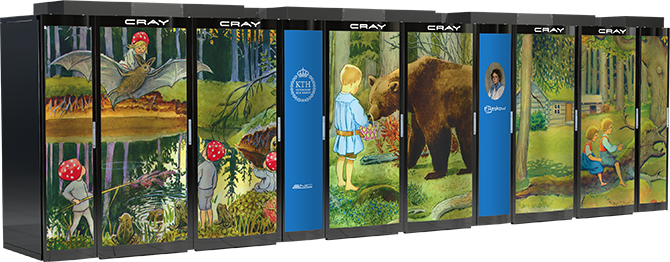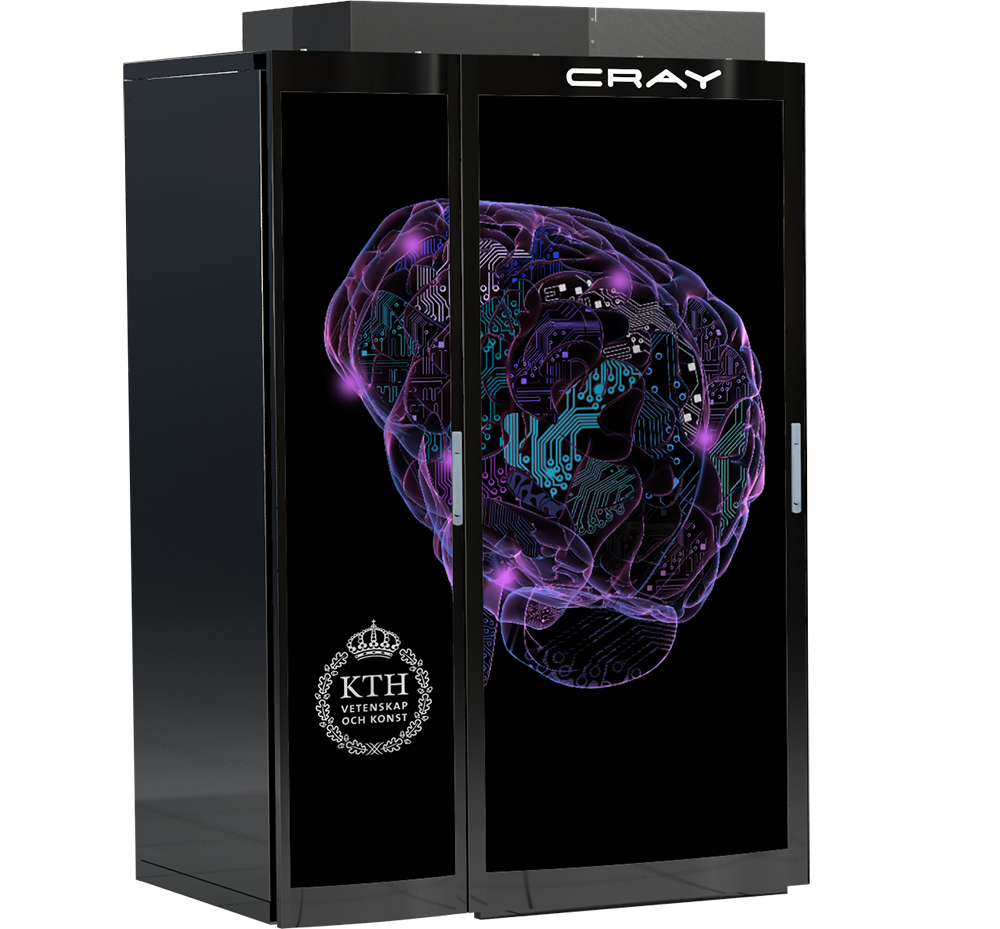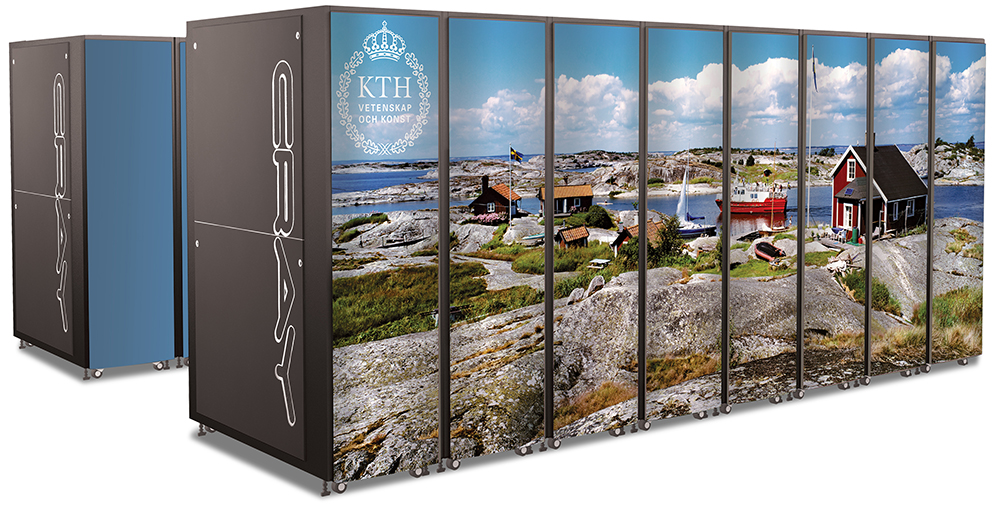Who inspired the system names
Are you curious about the names of PDC's supercomputer systems?
Dardel
Dardel is an HPE Cray XE supercomputer that is currently the flagship system at PDC. The system was named in honour of the Swedish author, Thora Dardel , and her first husband, Nils Dardel , who was a Swedish painter. The front panels of the Dardel system feature four paintings by Nils Dardel: “The Dying Dandy” oil painting (which is one of Nils’ most famous works), a section of the famously expensive “Waterfall” painting and a section of “Crime of Passion” (another of Nils’ well known works), plus a portrait of Thora. The background text on the blue panels is from Thora’s book about Nils (which is known as “En bok om Nils Dardel” in Swedish).

The Dardel system consists of two partitions - one based on CPUs and one that uses graphics processing units (GPUs) - split over two rows. Although the majority of supercomputer systems at PDC have been named after Swedish authors, PDC's earlier GPU-based system was named after the Swedish artist, Anders Zorn. Consequently, it seemed highly appropriate to name the new system after the Dardels, as Thora was an author and Nils was a painter. Although Thora and Nils divorced after 13 years of marriage, they remained good friends until Nils’ early death from a heart condition.
Interestingly, Nils painted “The Dying Dandy” in 1918 at the time of the great influenza epidemic that lasted until 1920. A century later in 2020, the world once more found itself in the grip of a deadly pandemic, so the choice of this painting also serves as a salute to the courage of the medical and care personnel who worked so hard to care for those infected during the COVID19 pandemic and also to the sorrow of those who lost their loved ones to the recent pandemic. It is also a reminder of the contributions supercomputers make in the fight against illness - for example, by being used to model how viruses actually infect people on a molecular level, which makes it possible to develop new types of vaccines.
PDC thanks the Modern Art Museum in Stockholm ( Moderna Museet ), and Prallan Allsten, for providing the high-resolution photo of "The Dying Dandy" that is used on the front panels of the system. If you are curious, you can see The Dying Dandy” at the Modern Art Museum. PDC also thanks the Modern Art Museum for the high-resolution image of “Crime of Passion”. The painting of Thora is owned by a private collector.
Beskow and Tegner
Beskow was a CRAY XC40 supercomputer that was PDC's flagship system from 2014-2021. Tegner was the pre- and post-processing system for Beskow.
The Beskow system was named after Elsa Beskow who is one of the most well-known authors and illustrators of children’s books in Sweden. The pre- and post-processing system for Beskow was named after Alice Tegnér . Alice was a Swedish music teacher, poet and composer, who was recognized as the foremost composer of Swedish children’s songs during the late 19th century and the first half of the 20th century. Elsa and Alice worked together to create many charming song books for children, with Alice composing the music and Elsa illustrating the books. Both Alice and Elsa lived in Djursholm in Stockholm and, almost a century later, the systems Tegner and Beskow were cooperating in a similar manner, albeit a little farther south at PDC in Norra Djurgården.

The panels on Beskow feature illustrations by Elsa Beskow from “Children of the Forest” (Tomtebobarnen) on the left, “The Land of Long Ago” (Resan till Landet Längesen) on the right, and the centre panel is from “Mother's Little Ollie” (Mors lilla Olle) which was a collaboration between Elsa and Alice Tegnér.
Milner
Milner was a Cray XC30 system at PDC that was used for neuroscience research starting in 2014. This system was sponsored by a grant from the the Swedish Research Council (VR) that was awarded to a consortium of researchers from the KTH Royal Institute of Technology, the Karolinska Institute and the International Neuroinformatics Coordination Facility (INCF). They named the system in recognition of significant work in neuropsychology that was done by Brenda Milner and her then husband Peter in the 1950s.

Lindgren
Lindgren was PDC’s flagship supercomputing system before Beskow. The system was named after the prolific and wonderfully talented Swedish author Astrid Lindgren , who wrote many delightful children’s books, including the famous Pippi Longstocking stories.

Key
Key was one of the first systems at PDC to contain GPUs. Although the system mainly consisted of CPUs, it also had two GPUs. The system was named after the Swedish author Ellen Key and began operating at PDC in 2011.
Zorn
Zorn was one of the first systems at PDC based on GPUs. It was installed in 2010 then upgraded in 2012 and was in use till early 2015. It was named in honour of Anders Zorn , who was one of Sweden’s foremost artists: he was a skilled painter, sculptor and etcher.
Ekman
In 2010, a Dell PowerEdge SC1435 Dual core Opteron 2.2GHz system was installed at PDC. The system was dedicated for climate research and flow simulations. It was named after Vagn Walfrid Ekman , a Swedish oceanographer (and gifted amateur musician) who, amongst other things, worked on fluid dynamics problems such as why icebers do not just drift in the direction of the prevailing wind.
Lenngren
A Dell PowerEdge 1850 3.2 GHz system was installed at PDC in 2005 and named after the Swedish author Anna Maria Lenngren .
Lucidor
In 2003, Hewlett Packard built an Intel 6000 rx2600 Itanium2 900 MHz system for PDC to replace the parts of Strindberg that were still in service. The system was built in a similar way to Roxette but was much more extensive. It was named Lucidor after the pen name of Lars Johansson , a Swedish baroque poet.
Roxette
In 1999, a system that was made from 15 Intel Pentium PIII-866 personal computers (PCs) was installed at PDC. At that time, high-performance computing (HPC) systems that were built in this way were known as “Pile-Of-PC” or “POP” for short. The system was named after the Swedish pop rock group Roxette (since it was “POP” compared to Swedish classics such as August Strindberg).
Selma
In 1996, a Fujitsu VX/2 distributed memory vector computer was installed at PDC. The system was named Selma in honour of the Swedish author and poet Selma Lagerlöf , who was awarded the 1909 Nobel Prize in Literature.
Strindberg
An IBM SP2 supercomputer was installed at PDC in 1994 and the system was named after August Strindberg , a Swedish author and playwright who was also a painter. The system was significant in the evolution of supercomputing systems for academic research in Sweden as the many upgrades to the system spanned much of the move from high-speed serial processing to the increasing adoption of parallel processing and the development of parallelisation techniques for coding.
Bellman
The first system at PDC was a Connection Machine (CM) that was installed in late 1989. It was named after the famous Swedish composer and poet from the 1700s Carl Michael Bellman , as his initials were “CM” just like the Connection Machine. Bellman’s music is still popular in Sweden - one of his most famous songs is “ Gubben Noak ”. Thus, a tradition of naming PDC’s systems after Swedish people who were famous for their creations in the arts was born.
